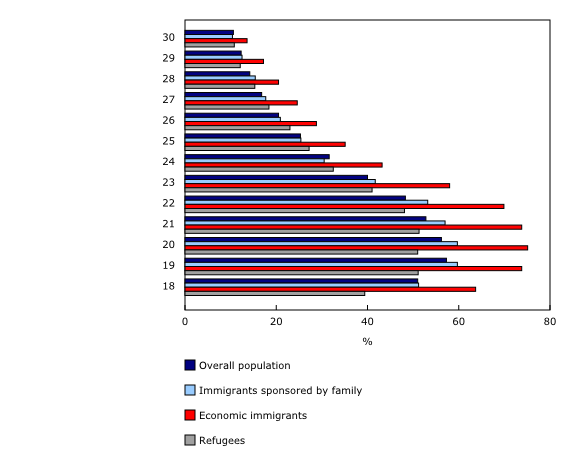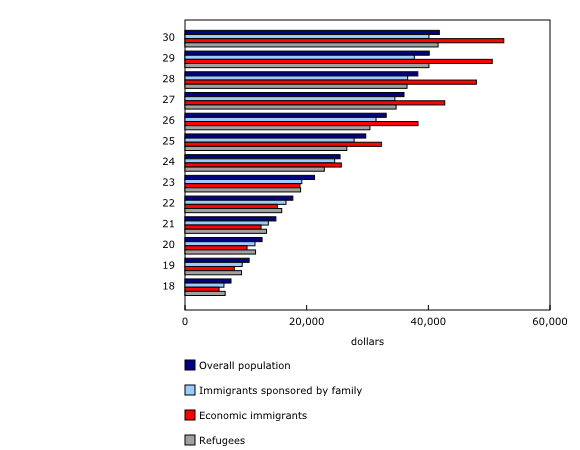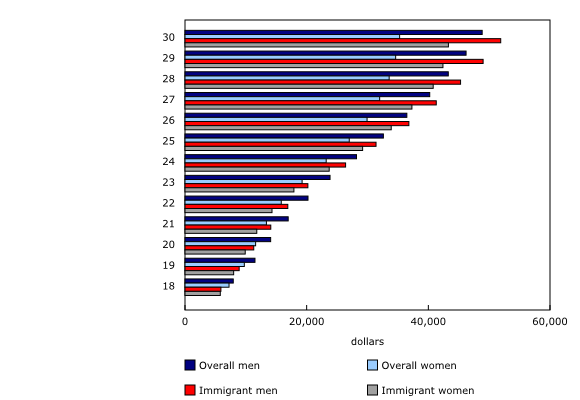Longitudinal Immigration Database: Immigrant children and census metropolitan area tables, 2018
Archived Content
Information identified as archived is provided for reference, research or recordkeeping purposes. It is not subject to the Government of Canada Web Standards and has not been altered or updated since it was archived. Please "contact us" to request a format other than those available.
Released: 2021-03-22
Socioeconomic outcomes of immigrants admitted to Canada as children, 2018
The most recent 2018 data from the Longitudinal Immigration Database (IMDB) indicate that immigrant children make a significant contribution to Canadian society and the Canadian economy over time. Although immigrant children (32.2%) are more than twice as likely as non-immigrant children (15.4%) to live in low-income households, factors such as the opportunity to be educated in the Canadian system and an increased proficiency in the official languages help immigrant children attain wages in adulthood similar to those of their Canadian-born peers.
This analysis connects the characteristics of immigrants who came to Canada as children with their adulthood socioeconomic outcomes in 2018, such as participation in postsecondary education and median wages. The IMDB provides a long-term perspective on immigrants and their socioeconomic outcomes in Canada, offering details on how immigration is shaping Canada's future. In addition, these data from 2018 contribute to baseline estimates in preparation for future research on the impact of the COVID-19 pandemic on immigrant children, including immigrant children admitted during the pandemic, their adjustment period and their long-term socioeconomic outcomes in adulthood.
Immigrants who came to Canada as children are more likely to participate in postsecondary education than the overall population
In 2018, 70% of 20-year-old immigrants who were admitted to Canada before the age of 15 participated in postsecondary education, according to tax data. This compares with 56% of the overall population of 20-year-olds in the same year.
Similar to the overall Canadian population, the median wage of immigrants who were admitted as children increased with age. In 2018, 25-year-olds in the overall population had a median wage of $29,710, compared with $30,300 for 25-year-old immigrants admitted as children. For 30-year-olds, the median wage was $41,810, compared with $47,400 for 30-year-old immigrants admitted as children. This represents a 13.4% difference in the median wage between the 30-year-olds in the total population and 30-year-old immigrants admitted as children.
Children admitted to Canada with economic immigrant families report higher postsecondary education participation than Canadians overall or immigrants admitted under other categories
Many factors influence the socioeconomic outcomes of immigrant children in adulthood, including the conditions under which they were admitted to Canada. Economic immigrants, selected for their potential to contribute to Canada's economy, tend to have a higher median wage than refugees, who are fleeing persecution or conflict, or immigrants sponsored by family already living in Canada.
Immigrant children who were admitted as dependants of economic immigrants are likely to benefit from the higher median wage of the principal applicant in the economic immigrant category. Among children admitted in economic immigrant families, 75% of those who were 20 years old in 2018 reported postsecondary education participation. This compares with 60% for children admitted in sponsored families, 51% for refugees and 56% for the overall population of the same age, in the same year.
At age 30, immigrants who were admitted to Canada before the age of 15 with economic immigrant families report the highest wages compared with those admitted under other categories
Lower participation in postsecondary education can lead to earlier labour market entry. Until the age of 23, people admitted as children in sponsored families, refugees and the overall population had higher wages than their economic immigrant counterparts. At this age, immigrants admitted as children in sponsored families had median wages of $19,200, compared with $19,000 for immigrants admitted as children in refugee families, $21,300 for the overall population, and $18,900 for people admitted as children in economic immigrant families.
However, beginning at the age of 24, a time when many have completed their postsecondary studies, the wages of people admitted as children in economic immigrant families began to surpass those of their counterparts in other admission categories and the overall population, and they continued to increase at a steeper rate over time compared with the other categories.
At the age of 30, in 2018, people admitted as children in economic immigrant families had median wages of $52,400. This compares with $41,600 for immigrants admitted as children in refugee families, $40,100 for immigrants admitted as children in sponsored families, and $41,810 for the overall population.
Immigrant women admitted to Canada as children have higher postsecondary education participation than men
In 2018, 74% of 20-year-old immigrant women admitted as children reported participating in postsecondary education. In comparison, participation rates were lower among immigrant men (65%) who also came to Canada as children. At 74%, the participation rate of immigrant women who came as children was also higher than the rate of the overall female population (62%) and the overall male population (50%) of the same age.
With regard to wages, 30-year-old immigrant women admitted to Canada as children had median wages of $43,300, 48% more than those of 25-year-old immigrant women admitted as children ($29,200). However, their median wages were lower than those of immigrant men who also came as children ($51,900) and of the overall male population ($48,850) of the same age. These gender income differences are in line with those in previous studies that found that women with a similar level of education as men report lower income.
Nonetheless, the median wages of 30-year-old immigrant women admitted as children were higher than those of the overall female population ($35,280), who earned the lowest median wages.
These new data will facilitate further analysis of other factors that can affect the future adulthood socioeconomic outcomes of immigrants admitted as children, such as their age at immigration, year of immigration and their incidence of living in a low-income household during childhood.
In addition to the table about the economic outcomes of immigrants admitted to Canada as children used in the analysis above, tables on the income and mobility of immigrants by census metropolitan area are now available. These tables use data from the IMDB.
Note to readers
Definitions and concepts
The Longitudinal Immigration Database (IMDB) is a comprehensive source of data that plays a key role in understanding the economic behaviour of immigrants and non-permanent residents. It is the only annual Canadian dataset that allows users to study the characteristics of immigrants to Canada at time of admission and the economic outcomes and regional mobility of immigrants over a period of more than 35 years.
The IMDB is the result of a partnership between Statistics Canada; Immigration, Refugees and Citizenship Canada (IRCC); and the provinces. The IMDB combines administrative files on immigrant admissions and non-permanent resident permits from IRCC with tax files from the Canada Revenue Agency (CRA). IRCC's administrative records contain extensive information on immigrants admitted to Canada since 1952. They also include information on non-permanent residents who have been granted a temporary resident permit since 1980. Fiscal data are available from the CRA's tax files for immigrant taxfilers admitted since 1980. Income tax records for 1982 and subsequent years are available for immigrant taxfilers.
The IMDB links short-term and long-term outcomes to characteristics at admission, such as immigrant admission class, country of origin and knowledge of official languages. The IMDB also provides information on pre-admission experience in Canada and citizenship acquisition since 2005.
For additional information regarding the data coverage and data quality of the IMDB, users should refer to the 2019 Longitudinal Immigration Database Technical Report.
Results from the IMDB are based on taxfilers,individuals who have filed a tax return for a given tax year.
This release analyzes income based on the medians of wages (for the population with wage, salary or commission income, excluding self-employment income). The median is the level of income at which half of the immigrant taxfilers have higher income and half have lower. Zero values are not included in the calculation of medians for individuals. All wage estimates are expressed in 2018 constant dollars to factor in inflation and enable comparisons across time in real terms.
Postsecondary education participation is defined as claiming tuition credits for oneself on the T1 tax return in the reference year.
Immigrant children, also known as Generation 1.5, are immigrants who were admitted to Canada before the age of 15. This release analyzes the socioeconomic outcomes of this population between the ages of 18 and 30.
Overall population figures come from the T1 Family File, which uses data from filed tax returns to estimate income and demographic information for the total Canadian population. For more information, users can access the Technical Reference Guide for the Annual Income Estimates for Census Families, Individuals and Seniors.
Sponsored family immigrants include immigrants who were sponsored to come to Canada by a family member who is a Canadian citizen or permanent resident.
Refugees include immigrants who were granted permanent resident status on the basis of a well-founded fear of returning to their home country. These include government-assisted refugees and privately sponsored refugees, as well as protected persons in Canada, and their dependants.
Economic immigrants include immigrants who have been selected for their ability to contribute to Canada's economy through their ability to meet labour market needs, own and manage or build a business, make a substantial investment, create their own employment, or meet specific provincial or territorial labour market needs. This category includes dependants admitted with the selected person.
Low income figures are derived from the 2016 Census of Population and refer to the low-income measure, after tax (LIM-AT). The LIM-AT is one of a series of low-income lines used in the census and refers to a fixed percentage (50%) of median adjusted after-tax income of private households. When the unadjusted household after-tax income pertaining to a person falls below the threshold applicable to the person based on household size, the person is considered to have a low income according to the LIM-AT. For additional details, users should refer to the Dictionary, Census of Population, 2016.
Products
The "2019 Longitudinal Immigration Database Technical Report" is available in PDF or HTML.
The data visualization tools "Longitudinal Immigration Database (IMDB): Interactive Application – Income" and "Longitudinal Immigration Database (IMDB): Interactive Application – Mobility" are available.
The infographic "Immigrants to Canada: Income trajectories and regions of settlement, 1987 to 2017" is now available.
The IMDB products are available on the Immigrant and Non-Permanent Resident Statistics Portal.
The 2019 IMDB immigrant children data module is now available upon request.
Contact information
For more information, contact us (toll-free 1-800-263-1136; 514-283-8300; STATCAN.infostats-infostats.STATCAN@canada.ca) or Media Relations (613-951-4636; STATCAN.mediahotline-ligneinfomedias.STATCAN@canada.ca).
- Date modified:




